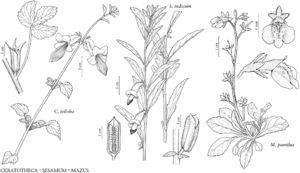Difference between revisions of "Sesamum indicum"
Sp. Pl. 2: 634. 1753.
FNA>Volume Importer |
FNA>Volume Importer |
||
| Line 31: | Line 31: | ||
|elevation=0–1000 m. | |elevation=0–1000 m. | ||
|distribution=Ala.;Calif.;Fla.;Ga.;La.;Mass.;Mo.;N.J.;N.Y.;Ohio;Pa.;S.C.;Tex.;Wis.;origin unknown;probably s Asia (India);introduced also in South America;Europe;elsewhere in Asia;n Africa;Pacific Islands;Australia. | |distribution=Ala.;Calif.;Fla.;Ga.;La.;Mass.;Mo.;N.J.;N.Y.;Ohio;Pa.;S.C.;Tex.;Wis.;origin unknown;probably s Asia (India);introduced also in South America;Europe;elsewhere in Asia;n Africa;Pacific Islands;Australia. | ||
| − | |discussion=<p>Sesamum indicum is the source of sesame seeds and sesame oil. It has been in cultivation for perhaps more than 5000 years; it is difficult to determine its native range. Sesame seeds are a component of many bird seed mixes, so plants often occur near feeders. The name S. orientale Linnaeus, which pertains here, has been rejected.</p> | + | |discussion=<p><i>Sesamum indicum</i> is the source of sesame seeds and sesame oil. It has been in cultivation for perhaps more than 5000 years; it is difficult to determine its native range. Sesame seeds are a component of many bird seed mixes, so plants often occur near feeders. The name <i>S. orientale</i> Linnaeus, which pertains here, has been rejected.</p> |
|tables= | |tables= | ||
|references= | |references= | ||
| Line 56: | Line 56: | ||
|publication year=1753 | |publication year=1753 | ||
|special status=Introduced;Selected by author to be illustrated | |special status=Introduced;Selected by author to be illustrated | ||
| − | |source xml=https://jpend@bitbucket.org/aafc-mbb/fna-data-curation.git/src/ | + | |source xml=https://jpend@bitbucket.org/aafc-mbb/fna-data-curation.git/src/8f726806613d60c220dc4493de13607dd3150896/coarse_grained_fna_xml/V17/V17_784.xml |
|genus=Sesamum | |genus=Sesamum | ||
|species=Sesamum indicum | |species=Sesamum indicum | ||
Revision as of 15:03, 18 September 2019
Stems simple or branched proximally, 4-angled, grooved, 30–100(–150) cm. Leaves: petiole 5–12 cm; blade narrowly lanceolate to ovate, 5–20 × 1–5 cm, base cuneate, apex acute, glabrate adaxially. Pedicels 3–5 mm; bracteoles 0–2, linear. Flowers drooping; sepals 4–8 mm; corolla 2–4 cm, glandular-pubescent externally, tube slightly curved at base, mouth 10 mm diam. Capsules 15–30 × 5–7 mm. Seeds 2–3 mm, smooth. 2n = (18), 32, 52 (Asia).
Phenology: Flowering Jun–Aug.
Habitat: Disturbed sites.
Elevation: 0–1000 m.
Distribution
Ala., Calif., Fla., Ga., La., Mass., Mo., N.J., N.Y., Ohio, Pa., S.C., Tex., Wis., origin unknown, probably s Asia (India), introduced also in South America, Europe, elsewhere in Asia, n Africa, Pacific Islands, Australia.
Discussion
Sesamum indicum is the source of sesame seeds and sesame oil. It has been in cultivation for perhaps more than 5000 years; it is difficult to determine its native range. Sesame seeds are a component of many bird seed mixes, so plants often occur near feeders. The name S. orientale Linnaeus, which pertains here, has been rejected.
Selected References
None.
